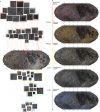Lunar impact crater identification and age estimation with Chang'E data by deep and transfer learning
- PMID: 33353954
- PMCID: PMC7755906
- DOI: 10.1038/s41467-020-20215-y
Lunar impact crater identification and age estimation with Chang'E data by deep and transfer learning
Abstract
Impact craters, which can be considered the lunar equivalent of fossils, are the most dominant lunar surface features and record the history of the Solar System. We address the problem of automatic crater detection and age estimation. From initially small numbers of recognized craters and dated craters, i.e., 7895 and 1411, respectively, we progressively identify new craters and estimate their ages with Chang'E data and stratigraphic information by transfer learning using deep neural networks. This results in the identification of 109,956 new craters, which is more than a dozen times greater than the initial number of recognized craters. The formation systems of 18,996 newly detected craters larger than 8 km are estimated. Here, a new lunar crater database for the mid- and low-latitude regions of the Moon is derived and distributed to the planetary community together with the related data analysis.
Conflict of interest statement
The authors declare no competing interests.
Figures







References
-
- Hartmann WK. Note: lunar cratering chronology. Icarus. 1970;13:299–301. doi: 10.1016/0019-1035(70)90059-X. - DOI
-
- Ryder G. Mass flux in the ancient Earth-Moon system and benign implications for the origin of life on Earth. J. Geophys. Res. Planets. 2002;107:1–13. doi: 10.1029/2001JE001583. - DOI
-
- Chapman CR, Cohen BA, Grinspoon DH. What are the real constraints on the existence and magnitude of the late heavy bombardment? Icarus. 2007;189:233–245. doi: 10.1016/j.icarus.2006.12.020. - DOI
-
- Bottke WF, Norman MD. The late heavy bombardment. Annu. Rev. Earth Planet. Sci. 2017;45:619–647. doi: 10.1146/annurev-earth-063016-020131. - DOI
Publication types
Associated data
LinkOut - more resources
Full Text Sources

